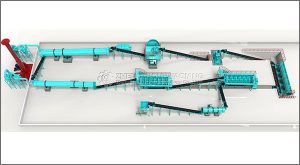Organic fertilizer mixer equipment is commonly used in organic fertilizer processing processes in three types: horizontal mixer, dual shaft mixer, and disc mixer. It plays a mixing and stirring role in organic fertilizer production processes.

- Mixing effect of organic fertilizer mixer:
A horizontal mixer uses the blades on the mixing shaft to select and lift the boredom and then drop it, completing one mixing cycle. The usual mixing method is suitable for the mixing and stirring of powder, small particles, and semi wet materials. The stirring effect is moderate. The production efficiency is average.
A dual shaft mixer uses a quantitative amount of raw powder to flow into the mixing tank from the feeding port, and is sprayed onto the raw powder through several certain pressure nozzles. The fixed length of the shaft is stirred by blades to form a ball core with consistent tax content, and transported to a pre added water ball forming plate. The entire mixing process is also divided into three areas: silent, well mixed, and unloading. Thus achieving a better mixing effect through a lower speed. The stirring effect is relatively good. High production efficiency.
The disc mixer adopts a white wire needle wheel reducer. The effect is moderate. The production efficiency is average.
- Comparison of wear resistance of organic fertilizer mixers:
Due to the high circumferential speed of the mixing blades and the rotation trajectory of the blades in a horizontal mixer, the wear of a single horizontal shaft mixer is greater than that of a double horizontal shaft mixer. Therefore, using expensive special steel increases maintenance costs.
Double axis mixer, the mixing blades of this organic fertilizer mixer equipment are mostly made of welded hard alloy blades, which have good wear resistance and long service life.
The disc mixer adopts a disc type vertical axis centripetal stirring, and during the circumferential stirring process, the stirring wear is medium and the wear resistance is medium.
- Comparison of production capacity of organic fertilizer mixers:
Compared with three types of organic fertilizer mixer equipment, the horizontal mixer has average efficiency and is lower than the dual shaft mixer. Stir between 2-15 tons.
The dual shaft mixer, due to the use of dual shafts, greatly improves the mixing efficiency, which is several times higher than the other two. The mixing volume is between 20 and 45 tons per hour.
A disc mixer is similar to a horizontal mixer, with average efficiency. Mix approximately 2-16 tons per hour.
- Comparison of load startup of organic fertilizer mixer:
Horizontal mixer, dual shaft mixer, and disc mixer can all be started under load.
- The transmission of the organic fertilizer mixer adopts belt transmission.
- Characteristics of organic fertilizer mixer: All three have overload protection, easy maintenance, and simple and convenient operation.
By understanding the characteristics and comparison of the three types of organic fertilizer equipment mentioned above, including horizontal mixers, dual shaft mixers, and disk mixers, one can have a reference basis for purchasing organic fertilizer mixer equipment. If the production capacity requirement is high, choosing a dual shaft mixer is ideal. If the production capacity requirement is not high, choosing a lower priced horizontal mixer or disc mixer.
